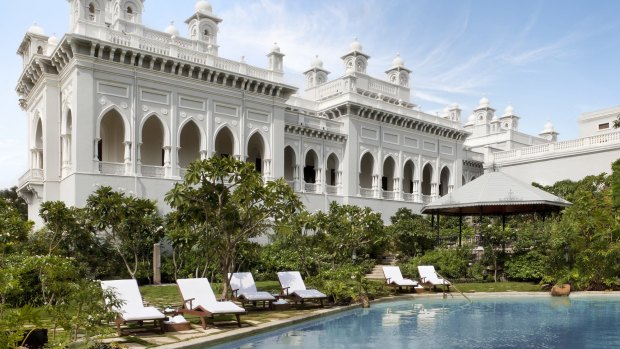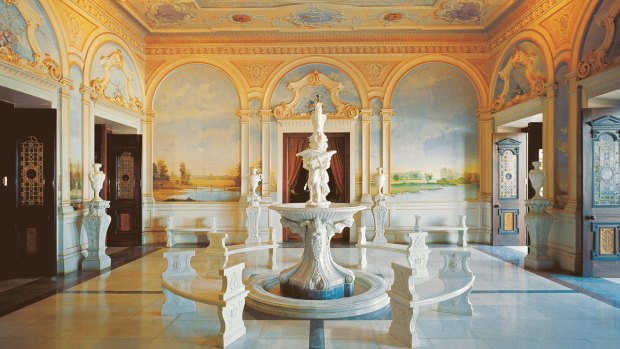This was published 4 years ago
Live like royalty at Taj Falaknuma Palace hotel in Hyderabad, India
By Andrea Black

Each guest is greeted in the same manner as the former royal residents of the palace.
The late afternoon traffic in Hyderabad's old quarter is snarling. Buses, trucks and rickshaws in varying degrees of decrepitude are honking horns while, by the side of the road, dogs are snoozing in the shade. Corrugated-iron fruit stands display tantalising bunches of grapes and watermelons, while flower merchants are packing up for the day.
Up on the hill at the Taj Falaknuma Palace, amongst landscaped lawns and fragrant gardens full of strolling peacocks, a chariot awaits us. Each guest here is greeted at the gatehouse in the same manner as the former royal residents of the palace, the Nizams of Hyderabad.
And so, here we are sipping champagne as a horse-drawn carriage deposits us at the palace entrance. As we ascend a sweeping marble staircase, rose petals are scattered from above.

Even the entrance is fit for a king or queen.
Mukarram Jah, the eighth Nizam of Hyderabad, was the last royal resident of Falaknuma Palace. He was, however, a monarch by title only as his grandfather, Osman Ali Khan, had been forced to accede the princely state to the Republic of India in 1948. Questions of leadership and royalty aside, the dynasty amassed an almighty fortune – at its peak in the 1930s – trading pearls, steel, gold and particularly diamonds.
Much later – after I've eyed off the cherub-flanked marble fountain, the grand palatial suites, the giant portraits of visiting kings and queens in gilded frames, and the 101-seat long table somehow upstaged by the Belgian chandeliers above it – I learn that Jah left all this grandeur to move to a sheep station on the Murchison River in Western Australia in the 1970s. There, he donned overalls, rode bulldozers, became a shepherd and was known to locals as The Shah.
Of course, there's more to the story. Litigation and money troubles followed him in Hyderabad after India's princely titles were abolished in 1974. The Nizam's wealth plummeted and his properties, including Falaknuma Palace, fell into disrepair.
A blind date with a Perth woman also made settling in Western Australia more tantalising and Helen Simmons became the Nizam of Hyderabad's second wife in 1980.
Though Jah shunned the spotlight, Simmons came to enjoy Perth's glitterati set (these were the heady days of the high flyers on the west coast). Perth residents eagerly opened the social pages of the Sunday papers for a weekly dose of royal scandal but could not have possibly foreseen the tragic ending. Simmons had an affair, contracted AIDS and died in 1989. Later, the Nizam fled to Turkey, where, at 84, he lives to this day. But he retained his stake in the hilltop palace in Hyderabad, which had been looted and then sealed in the years after his departure.
It was Jah's first wife, Princess Esra who, at his behest, returned Falaknuma Palace to its former glory. In a labour of love that spanned a decade, the grand cobwebbed rooms were restored and revived, becoming a Taj Hotel in 2010.
On an in-depth tour of Taj Falaknuma (a daily occurrence at 5.30pm) with the hotel's librarian, Asif Husain, it is clear that everything has been painstakingly restored to look as it might have in the late 19th century, when the palace was built. Guided by archival photographs, Princess Esra retained a veto on every aspect of the design.
Upstairs, in the once men-only Hookah Bar, the sixth Nizam would entertain his guests, perhaps hunting buddy Franz Ferdinand, maybe Tsar Nicholas II, or King George V. Today, guests drink cognac while playing billiards on the oversized mahogany table, surrounded by various portraits of the Nizam with dead tigers.
Sitting back on an overstuffed camel-leather sofa (said to be dyed 200 times to get the worn vintage look) and sipping Nizami Gimlets (saffron-infused gin with fresh lime juice and gomme syrup), we learn that the palace's architect, William Ward Marret, drew inspiration from baroque, renaissance and rococo design which made the visiting European elite feel very much at home. Marble was shipped in from Tuscany; furniture from France.
Back in the late 19th century, while the menfolk discussed their latest kill or boasted that one of the world's biggest diamonds, the 187-carat Jacob diamond was being used in the palace as a paperweight, the women would gather in the Ladies Gossip Room downstairs to talk over tea. The room's centrepiece is a round velvet couch which, our guide tells us, is good for whispering the day's goings-on in a circular fashion.
The elaborate parquetry floors of the ballroom, the jade trinkets in the Jade Room, and the 30-metre long dining table are all impressive, but the library is the real highlight. Said to be modelled on the library at Windsor Castle, the rosewood and mahogany shelves hold 5970 books in nine different languages. The diverse collection includes books of Urdu poetry, Persian travelogues, HG Wells first editions, and the very first set of the Encyclopaedia Britannica.
Dinner is served on the terrace of the palace's Gol Bungalow restaurant, under a stained-glass dome. The lights of the city twinkle below and the call to prayer echoes from mosques across the city. We're welcomed with the restaurant's signature jasmine martini and sit down for a feast that includes a selection of royal Hyderabadi delicacies, the highlight of which is a biryani, the state's most famous dish.
The call to prayer makes way for a Sufi qawwali performance on the balcony, where spirited singers are accompanied by a harmonium, a tabla and percussive hand clapping. A nightly event at this Taj, the music is haunting and beautiful.
A morning yoga class by the pool is accompanied by the calming clip-clop of horses ferrying new guests to the palace. Back in my room a butler is drawing a rose and jasmine-infused bath.
One might wish to spend the rest of the day horse riding, enjoying a spot of croquet or a treatment at Jiva Spa, watching the daily peacock feeding or taking part in a Hyderabadi bangle-making class. In the Jade Room they are setting up a bazaar featuring silver, pearls and perfumes. The Nizams were known to be patrons of the Indian perfumers who made attar, or natural perfumes. It's all part of the plan to bring back some of the grandeur of the days of the Nizam to the city of Hyderabad; a fairytale ending of sorts for Princess Esra, who has her own residence on the grounds of the palace.
Night falls again. Young local couples on weekend escapes are strolling the grounds, taking in the opulence. Hyderabad is now also a city driven by the IT industry and the shiny high-rise sector to the north-west is nicknamed Cyberabad. The young couples have the cash to enjoy the royal lifestyle here, to live like princes and princesses, if only for a few nights.
Wandering back to my room after dinner, I encounter a waiter clearing plates from a private table for two. On the ground, written in rose petals, are the words "will you marry me?".
"What was the answer?" I ask the waiter.
"They left very happy," he says.
TRIP NOTES.
MORE
FLY
Singapore Airlines fly to Hyderabad via Singapore and Delhi. See singaporeair.com
Andrea Black was a guest of Adventure World Travel and Taj Hotels.
STAY
A two-night stay in a Palace Room at the Taj Falaknuma Palace costs from $1570 and includes breakfast, airport transfers, a private full-day tour of Golconda Fort, Qutub Shahi tombs, Charminar, Mecca Masjid, Salar Jung Museum and the Chowmahalla Palace. See adventureworld.com.au
TOUR
Adventure World Travel can tailor-make south India itineraries that include Taj Falaknuma in Chennai, a private driver and guide, plus daily excursions. See adventureworld.com.au
5 MUST-VISIT SITES IN HYDERABAD
CHOWMAHALLA PALACE
Princess Esra also brought Chowmahalla Palace back to its former glory and it's now a museum and some of the Nizam's car collection, including a Rolls-Royce Silver Ghost, is on display here. There are also handwoven textiles and embroidery on show. Don't miss the Coronation Room which features 40 chandeliers.
CHARMINAR
This 16th-century mosque, with its distinctive minarets and grand arches, is one of India's most recognised structures. It was built in the centre of the city to commemorate the eradication of cholera.
LAAD BAZAAR
The Charminar is surrounded by the stalls of this bazaar. Expect to find glittering bangles galore, as well as perfumes, saris and shoes. Need sustenance? Stop in the Nimrah cafe and bakery for Irani chai and incredible Osmania biscuits.
GOLCONDA FORT
This sprawling hillside fort offers spectacular views of the city. Some of the world's finest jewels were once kept here, including The Kohinoor and Hope diamonds.
PURANI HAVELI
This former Nizam palace was built more than 200 years ago and has a museum showcasing some of the artefacts of the last ruling Nizam of the state of Hyderabad.
Sign up for the Traveller Deals newsletter
Get exclusive travel deals delivered straight to your inbox. Sign up now.